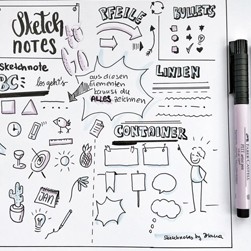
No more chaotic piles of memos, and no more annoying reminder apps: The latest trend in scheduling is known as "Bullet Journaling". It uses pen and paper, which is presumably precisely the reason behind its astonishing success. The system, which was "invented" by New York graphic designer Ryder Carroll, is based on a notebook with blank (or lined/checked) pages that can be arranged to create a customised calendar: Using a table of contents and a yearly overview, users divide up their to-do lists into monthly, weekly and daily plans, and can add extra pages for personal projects or interests. Tasks are marked using bullet points, arrows or "X" symbols, allowing users to see at a glance which tasks have already been completed, and which "uncompleted" tasks need to be moved to the following page. As simple as it is efficient, the technique already has hundreds of thousands of fans, who exchange information and tips relating to their Bullet-Journal experiences on blogs and on Instagram.
Faber-Castell provides attractive and useful tools to help you: The Textliner 46 is now available in eight pastel colours – vanilla, apricot, purplepink, lilac, pale blue, ultramarmine, turquoise, light green – in compact sets of four or eight. Their long-lasting wedge tip offers three different line widths, making them great highlighters for all that’s important to you.

1. The first page should contain the table of contents (it’s better to allow two pages so there’s room for extra topics). Consecutively number every page of the journal so that the index serves as a finder. The table of contents should list calendars, topics, lists, projects, ideas, extras, etc., followed by the page number(s), depending on the scope of each topic. Keep a few pages blank for spontaneous ideas.
2. Which symbols, rules and systems should be used? Define bullets and other labels and write them down.

3. Annual overview/calendar: an overview of the (remaining) months of the year, including birthdays, holidays, weddings and other events that are scheduled in advance.
4. Personal objectives (future log). Which topics will characterise the coming period? What do you want to achieve by what date?
5. Monthly overview/calendar. Like the annual calendar, it also contains all existing dates and tasks.

6. Weekly overview. This can be broken down, e.g. for work-related, household and family obligations.
7. The daily pages. Add tasks, deadlines, meetings, etc. Examples of additional items: lists (expenses, kilometres driven), joyful moments, workout updates, etc.

8. Individual components: e.g. moving project, holiday ideas or new yoga poses: Anything that's part of your personal daily routine – and which is key for successful annual planning.

"Bujo is really easy – I have set up a weekly overview and a monthly overview for 2018. This means that my personal organizer is clearly structured and I have a constant overview of the entire year. I don’t just enter business dates in my journal, but private and leisure activities too. I assign different colours to specific things – I mainly use light, soft pastel shades. I also use bullet points that I draw and colour in. My bullet journal is also a kind of diary that I like to look through. Sometimes, I decorate the pages with fun doodles and sketches. I often use handlettering and calligraphy for headings. Bullet journals aren’t just notebooks – they help me to structure my thoughts and drawing the little sketches and letterings helps me to relax. Bullet journaling helps me to keep an overview of my present, plan my future and lovingly document the past."
"I love the new textliner in pastel shades. The chisel tip enables three line thicknesses, so I can highlight, write or simply colour in text. The delicate colours are perfect for my bullet journal, a great agenda system that helps me organize myself effectively and creatively. I can assign professional and private things or things that affect me a specific colour, thus providing a better overview of my to-do’s! And it looks great in my notebook too!"
Sketchnotes are visual notes consisting of a mix of handwriting, drawings, symbols, hand-drawn typography and graphic elements like arrows, boxes and notes. With Sketchnotes, it's not just about the art, but the idea behind it.
"Complex ideas can often be portrayed more effectively with drawings. The quick stroke is typical for Sketchnotes, as speed is often key with this type of note-taking. Two pens are therefore often all you need. One for drawing and one for adding accents. The Pitt Artist Pen S is perfect for writing and drawing and the Pitt Artist Pen B is ideal for highlighting or shading. Light colours like “ICE Blue” 148 and LICAC 138 add a touch of colour without overloading the picture! Simply perfect!"